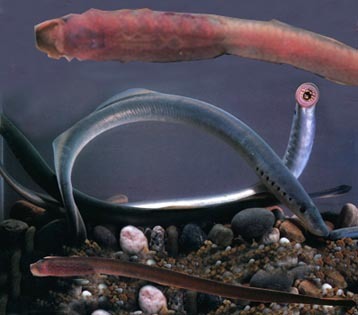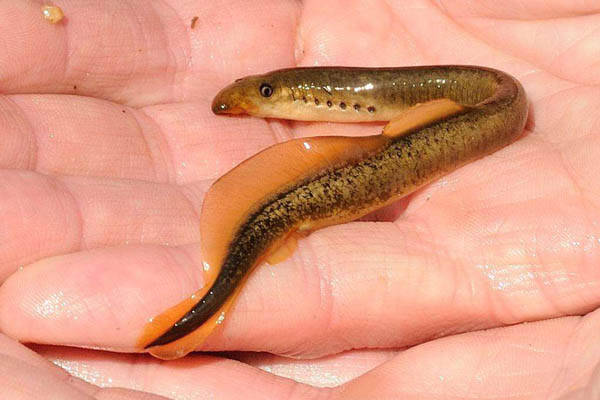
Alias Lampetra japonicaMartens,Lamprey, Japanese lamprey
Family Cyclostomidae Lampreydae Lampreyidae Lamprey
The Latin name of Japanese lamprey is Lampetra japonicaMartens, and the species' type origin is in Japan.

Japanese lamprey is a carnivorous fish. It lives both independently and parasitically. It often attaches itself to other fish with a sucker and uses the keratin teeth inside the sucker and on the tongue to file the fish's body and suck its blood and flesh. Sometimes, only the skeleton of the fish is left. When living independently, it feeds on zooplankton. During the larval stage, it feeds on humus debris and filamentous algae. Adult fish stop feeding during the reproductive period.
Japanese lampreys enter rivers from the sea in autumn every year, spend the winter, and spawn in May-June of the following year. They dig pits in shallow waters with fast currents and gravel bottoms to spawn. The eggs are small and numerous, with each female carrying 80,000 to 100,000 eggs, with an egg diameter of 1.0-1.2mm. The eggs are sticky and develop on the gravel. The parents die after spawning. The hatched larvae live in rivers for about 4 years and enter the sea after completing the metamorphosis at the river mouth. After metamorphosis, the digestive system maintains digestive function and has a parasitic nutrition period of about 2-3 years; most adults are 390-500 mm long, and the largest individual is 625 mm long.
Japanese lampreys are typical migratory fish and live in the sea for part of the time. They enter rivers from the sea in autumn and hibernate in the lower reaches of rivers. In May and June of the following year, when the water temperature reaches about 15℃, they go upstream to reproduce. Lampreys choose shallow, fast-flowing, gravel-bottomed waters to dig pits and build nests for spawning. The male fish sucks the female fish's head with a suction cup, ovulates and fertilizes at the same time. The eggs are extremely small, with 80,000 to 100,000 eggs laid each time, and the eggs stick to the gravel in the nest. All the parents die after spawning. The eggs become larvae shortly after hatching. The larvae live in mud and sand, buried under the mud and sand during the day, and come out to feed at night. The larvae at this stage are very different from the adult fish. The oral sucker is not well developed and is triangular. They are called sand-hidden larvae and live a free life. The life span of lampreys is about 7 years. After living in rivers for 4 years, the larvae metamorphose and go to the sea in the 5th year. After living in the sea for 2 years, they go upstream to spawn.
The adult fish of Japanese lampreys can reach more than 60 cm and weigh about 0.25 kg. They can be eaten. It has a high fat content and is a precious edible fish. The fish body also contains befaine, creatine, etc. In addition, the content of protein, vitamin A and D is relatively high. The body of lamprey can be used as medicine. The medicinal properties are sweet and warm, and it has the effect of nourishing and strengthening the body; it is mostly used to treat facial paralysis, night blindness, corneal dryness and other symptoms.
The resources of Japanese lamprey are quite small and are in a vulnerable state. The main cause of the endangerment is the impact of soil erosion, the destruction of spawning grounds and the living environment of young fish, and the impact of water pollution on the living environment. There are no effective protection measures.
Listed in the second level of the "List of National Key Protected Wildlife in China".
Protect wild animals and eliminate game.
Maintaining ecological balance is everyone's responsibility!